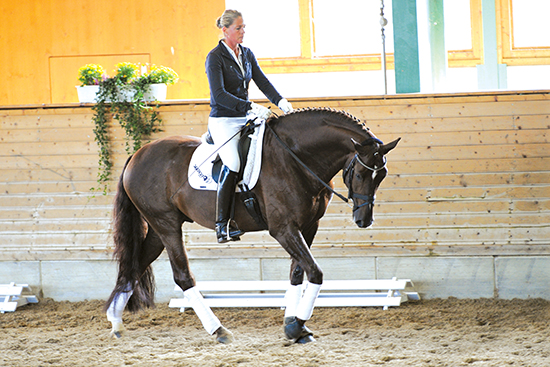 Story by Chris Hector and photos by Roz Neave and Roger Fitzhardinge
Story by Chris Hector and photos by Roz Neave and Roger Fitzhardinge
Last month The-Seminar-to-end-all-Seminars at Warendorf took us through the Basics with the younger dressage horses. This month we move on to the Five and Six year olds, and travel right through to Grand Prix with some very special riders, trainers and horses…
The next rider is one of my favorites – Kathrin Meyer zu Strohen is so elegantly tactful, and I loved her horse, Rassolini (Rubioso / Silvano) when he was 4th in the six year old dressage class at the weekend. It’s Kathrin’s husband, Hans-Heinrich on the mike:
“What’s happened you are asking? This horse is muscled like a seven year old – but the truth is that some stallions get their muscle earlier. There is good natural activity in the canter, it could be a little more up in front, but I say, wait, wait a year – when you have time, you have a chance of success.”
“We train so we get absolutely clear rhythm. When you see the walk you say ‘oh my god what a big walk’ now it is a ten but later when you get the horse together, come the problems. But if you wait, if you get activity and contact, then you find you can shorten the walk and the takt is absolutely clear – see even when he does a 360 pirouette, when he walks out, he is absolutely clear.”
“In the canter there, he was a bit lazy in the flying change, so we ask a bit more forward – it doesn’t matter about straightness at first – more important is the rhythm. Sometimes we find one side is good, one side is shit. Then we train the shit side, but we don’t train the flying change – we train the rhythm, the bend, the looseness… and then we try the flying change.”
“It’s the same in the shoulder in and the half pass – keep the rhythm. When the rhythm is clear, the movement is okay. All the time, the rhythm must be clear…”
Once again, Dorothee Schneider this time the six year old Hanoverian stallion, Florinero – by Fürst Heinrich out of a mare by A Jungle Prince. The pair were second at the World Championships in Verden, but at the Bundeschampionate, finished in equal 4th, in a somewhat puzzling judging decision. Later in an interview with Christoph, Dorothee made it quite clear that she thought the stallion should have placed higher in the class than her mare, La Noire, who finished in second place. “Wait until they come out next year in the Burgpokal (Prix St George for young horses), then you will see…” says Dorothee.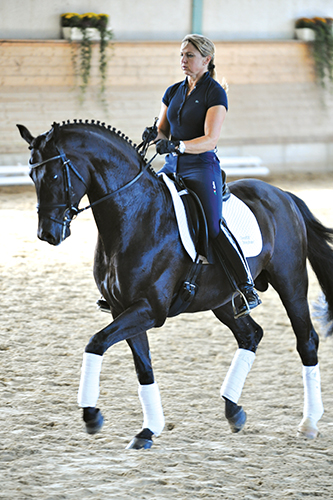
Florinero with Dorothee Schneider
Dietrich Plewa has asked Dorothee to show some shoulder-in, and he is focusing on the quality of the trot: “In shoulder-in the most important thing is the rhythm and the quality of the collected trot – you should punish errors of rhythm because they show the horse is losing balance. Now you see in this half pass, that the horse is very fluent. The first question in half pass is, is the horse able to keep the quality of the rhythm? You see now, a half pass with great crossing and rhythm.”
There had earlier been some discussion of the way in which many horses lose the four beat quality of their walk in the walk pirouette and some discussion of where the marks for the loss of rhythm ought be deducted. According to Christoph: “Dorothee is a good rider, and she took the risk, her walk pirouette was very small but she kept the four beat rhythm. If they don’t, they should be punished in the submission mark.”
“In the six year old class, it is not really that the horse stands square, it is more important that the horse is happy to stand… not like some Grand Prix horses…”
Christoph is back on the mike: “You see how difficult the test is for the six year olds. At the weekend, we saw last year’s winner of the 5 year olds, Imperio, last year he did one of the best tests for a five year old that I have seen, but this year, he had to do four flying changes, and that was the problem. There are only 28 horses in the six year olds, I am sure many did not come because they had problems in the shoulder-in, half pass and flying changes.”
Showing the Five Year Old Dressage Horse
Hans-Peter Bauer had a horror ride in the Final of the 5 year old dressage horses, when his mare, Rock’n Rose (Rockwell / Pinocchio) actually fell during the test. Hans-Peter, who is a large lad, kept his cool and his seat, and the mare came off the dirt with him in place, and continued the test. She had, not surprisingly, lost a lot of confidence…
Christoph is sympathetic: “This horse has had a difficult week so today we do a bit of basic training. Maybe she didn’t have a good feeling when she left the ring yesterday, today, we try to get her 100% happy and relaxed.”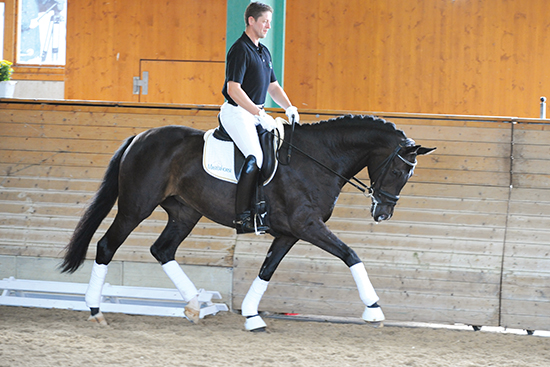
Hans-Peter Bauer and Rock ‘n Rose
After some nice walk, Christoph asks for trot: “Light trot, natural trot with a positive tension – that comes from suppleness. When the horse is supple, then the rider can ask for more, the moment of suspension a bit longer, then we have better swinging, better impulsion. See with this rider, he is nice, he gives his horse the chance to look around.”
“This is a natural trot with very positive body language. Yesterday in the test, the horse was against the left leg in the canter. Circle and then a little shoulder in tendency to make her straight. There should be no more than one or two goals in a training session, and after yesterday, the main goal is to make her happy.”
The next horse in the arena was one of the real stars of the Bundeschampionate, Eva Möller’s five year old champion, Blinkpunkt (AMAZING that the organizers of the Seminar could get horses like this to come back after five long days at the Bundeschampionate). Again, husband Ulf is doing the commentary: “Even in the warmup on the long reins, you can see he has a super active hind legs – that comes from nature, it cannot be made. I say to Eva, you must be more strict, and she says, no, we do it our way. This horse is very shy – he’s not bucking or anything, but he takes everything inside but because of the confidence he has with the rider, especially in the ring where he is alone, it isn’t a problem. There is just something between this horse and this rider.”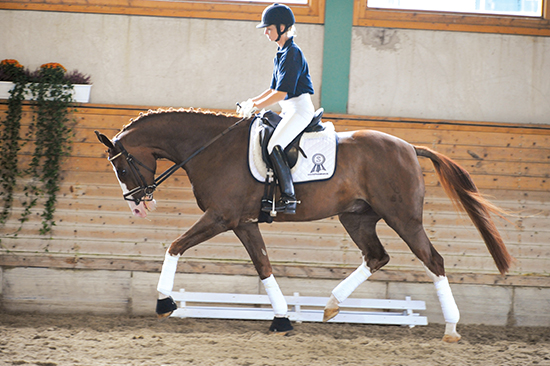
Eva Möller and Blinkpunkt
“I bought this horse when he was four, five weeks old, and even then, he trotted like this, it was not hard to decide…”
Dietrich Plewa took over the commentary to talk us through the test:
“A very good halt, square. Now look at the activity of the hindlegs, the balance, impulsion, steadiness and the contact in the serpentines. We are looking for natural cadence and this horse has an optimum natural cadence.”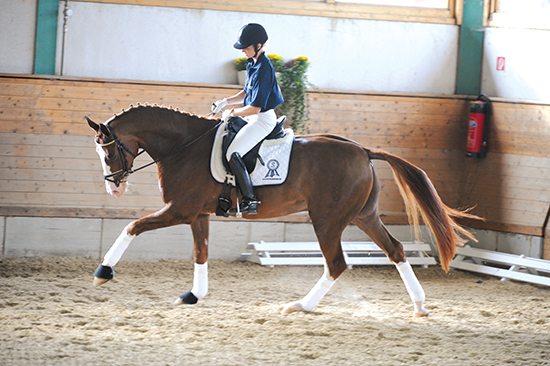
“The horse has a huge medium trot without getting quicker. The mark for the trot? Nine or more – ten? What more do you want? Such a clear rhythm, balance, activity of the hindlegs, it is all of the highest quality that you can imagine.”
“The walk is clear, four beat, over-tracking three footprints, coming from the shoulder in a relaxed lengthening with the neck following the bit. It is not a huge walk but a walk you can use for higher competitions… now we can discuss the mark, but between 8 and 9.5.”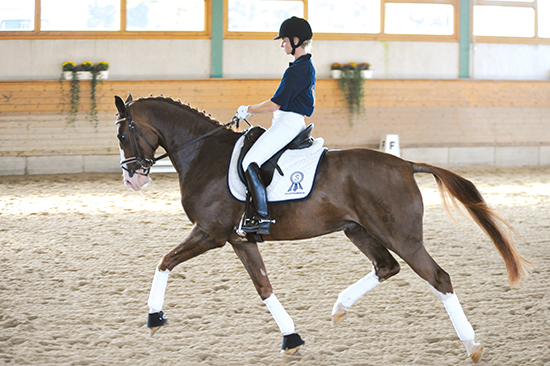
“Very active canter. Not too lazy, not too slow, and showing the ability to collect. The nose is always in front of the vertical, the poll the highest point, and really straight with a light, steady contact – straight in the counter canter with no loss of balance, and now with the reins longer, there is no loss of natural cadence. I must say, I am deeply impressed. The canter, a mark between 9 and 9.5. Submission, the same, 9.5. General impression – 9.5.”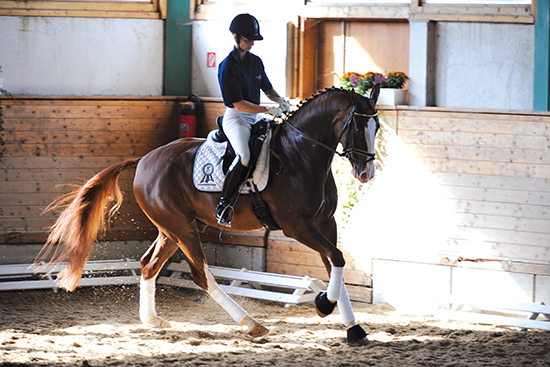
“I’ve been riding him for three years,” Eva says. “The most important thing is that the horse feels good, sharp in the mind. It is the rider’s task to support the horse and let him feel strong.”
Moving on to FEI…
Unbelievably, the parade of star horses, continues. Back in 2005, Kathrin Meyer zu Strohen, won the Six Year old Dressage Bundeschampionship, riding the Trakehner stallion, Kaiserdom (Van Deyk / Gajus). It’s exciting to see how the combination has been developing. Kathrin’s husband, Hans-Heinrich takes the mike:
“Why so many stallions? My wife likes stallions, but sometimes when you have stallions, you have more problems in schooling… Bend him round the inside leg. We are schooling the body of the stallion.”
In the canter, Kathrin shows a real uberstreichen, not a quick momentary flick, but a sustained release of the rein for four or five strides, and then the horse is back in hand before he decides to do a little tank off:
“That’s not a problem, he’s a stallion, he must be alive in his head.”
Hans-Heinrich approves of his wife’s pirouette: “Super pirouette, the neck under control, good in the hand. PRIMA! In the flying change, he lost a little the speed. Forward again, train the canter and then you have the movement.”
The horse shows some really nice passage: “Here you see what we have in our system. The clear half halt. The clear rhythm. School the body and the head of the horse and then they can learn all the movements. Don’t train piaffe and the passage too early. First the basics, the rhythm clear, the body under control, then it comes easy, then you just play… that is fabulous piaffe, now he must have a rest. We are lucky, they are breeding such super horses these last few years.”
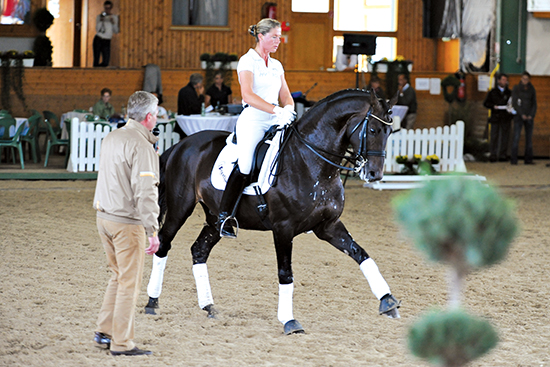
Kathrin Meyer zu Stohen on Kaiserdom in the arena with Hans-Heinrich
Next into the arena came Uta Gräf, this time riding her Holsteiner, Le Noir, by a son of Landgraf out of a grand-daughter of Cor de la Bryère. This horse has competed successfully at Prix St Georges and Intermediaire I level, despite not being bred, or for that matter, conformed to be a dressage horse. The pair had put on a demonstration on the Sunday at the Bundeschampionate, with Christoph drawing attention to the fact that the rider was getting most of the FEI movements done while riding one handed, but was she getting them done well? It reminded me of one of the classic lines from Joyce Carey’s famous novel, The Horse’s Mouth, where the artist hero Gully Jimson observes it is ‘like farting Annie Laurie through a keyhole. It may be clever but is it worth the trouble.’
Still Christoph loves it: “Philippe Karl is always criticizing our riders, every day I get an email saying we are on the wrong way with our theory. Uta is a very good example of why this guy is wrong. Look there is no using hands against the bit – she is using hands to feel the happiness of the horse. The hands are important to talk to the horse, to listen to the horse, the hands are a mirror to the soul of the horse.”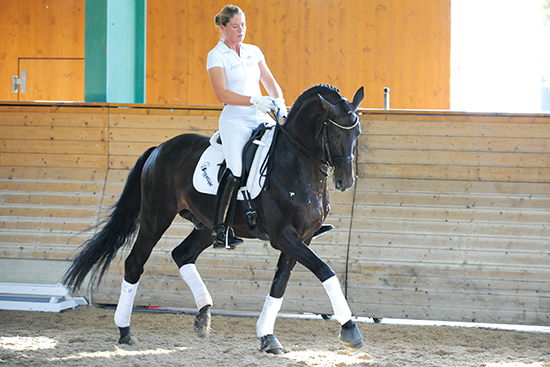
And yes, it was a dear dear very cooperative horse, but was it great dressage?
In this matter I beg to differ from my friend Christoph, who is of the opinion that: “This for me is not circus, this for me is the classical way of riding. I can watch this kind of riding day or night.”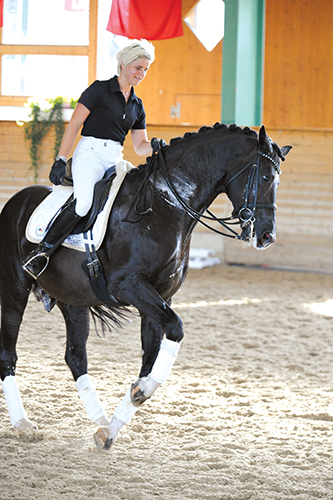
Samba Hit was a star at the Bundeschampionate, when he was a reserve champion in the Three Year Old stallion class in 2001 (the year before his full-sister, Poetin had won the championship for 3 year old mares and geldings – two years later she was to win both the 6 year old championship and the World Championship) – since then he has progressed steadily through the ranks, brilliantly ridden by Christian Flamm, with the training assistance of Hans-Heinrich Meyer zu Strohen. Now eleven years old, he is on his way to Grand Prix.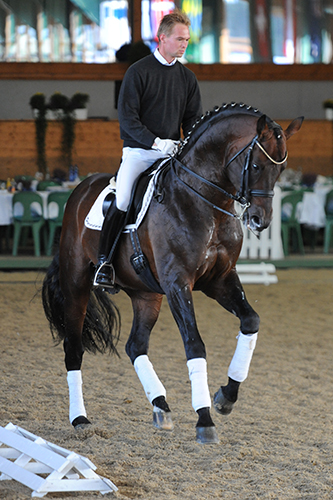
Hans-Heinrich says it was not easy: “For some horses, when they are as huge as this, it takes longer to get everything together, to get the activity and the bend. When you are training a stallion, you have no chance to train him 365 days a year, there is a long time when he is breeding and you can just ride him – you can’t train him.”
“It is not easy to get this huge canter more together, the rider must have a top seat.”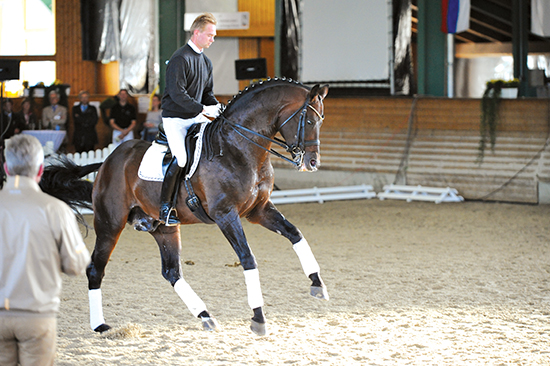
For all that it is a lovely big canter and super flying changes. Still Hans-Heinrich is hard to please: “You can see the jump and the straightness are good but we need more balance, we have to train the horse going forward, so we don’t get it too short. We need to train the changes a little more out of collection, to get more balance and expression. To get collected canter is hard work for this horse but you will see what is super is that the hindquarters are coming shorter and shorter and more under himself. We must wait a little to get it more under control and more on a place. If we try to force the horse to go smaller, he will lose the balance and the rhythm, and then it is hard for the horse and he gets angry and we lose everything. You can train a horse with activity, but you should not always be pushing.”
Training the Young Rider…
The next rider into the clinic is from one of those famous German riding families: Fabienne Lütemeier is the daughter of German international representative, Gina Capellman-Lütemeier and her aunt is former World Champion, Nadine Capellmann. Despite that, she rides very stylishly indeed on her D’Agostino gelding.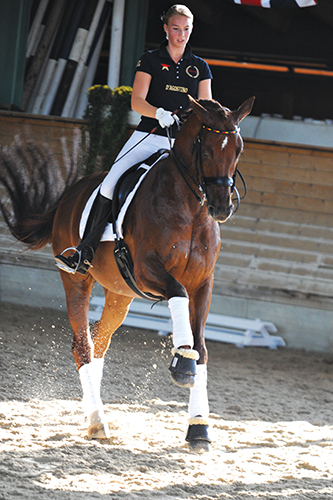
Fabienne Lütemeier on her D’Agostino
This time, Hans-Heinrich, who is the German Young Rider coach, is paying tribute to the qualities of the young rider. “As a trainer, I prefer riders who say, ‘we will’. You must have a horse AND a rider – if the rider is not strong enough, you lose the competition. At the last European Young Rider Championships, Fabienne was second twice and it was too much for her. She said, ‘I will win the next one’. It was very hard, the rider who had beaten her was just before her… “oh she has a 77, I must make 78’. She willed this and she did it.”
“Just look to the quarters of the horse, the horse is really stepping under. Don’t forget what we’ve said: walk, trot, canter – not trot, trot, trot.”
The work from the young rider and her horse is wonderful. Forward, athletic, relaxed. The entire Seminar has been a wonderful showcase for a training method that is simple, logical and horse friendly. A wonderful opportunity to look at the way breeding, judging, training – and showing – all combine to produce the horses that we are seeing today: horses of such enormous natural ability and presence.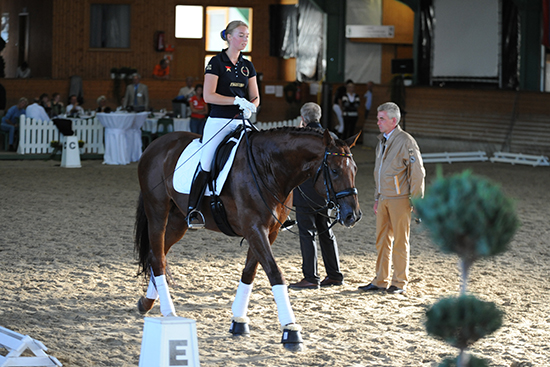
And yes, in keeping with the amazing standard of the horses that were used at the Seminar, two more were brought into the arena to demonstrate Dr Plewa’s talk: Hans Bauer riding a Walt Disney / Eiger and Kathrin Meyer zu Strohen riding Kaiserdom.
Christoph Hess commented on Hans’ performance: “Here we see an example of positive harmonious tension, we need positive tension otherwise the horse is not sensitive enough to the driving aids. Not negative tension but positive tension. The horse can lengthen and still maintain the rhythm. See the horse is supple. The mirror to the horse is the mouth and the tail, especially in the walk. This is a big of an old fashioned Hanoverian but he shows a very high standard of elasticity.”
Hans-Heinrich is commenting on Kathrin’s work: “In piaffe, what is most important is a clear two beat rhythm, later the horse can give a better impression, but first the rhythm. See for this horse, it is a pleasure to do piaffe…”
“In the extended trot, it is a wonderful picture, an open poll, the horse stretched, this is asking in exactly the right way. This is a well relaxed horse, showing positive tension and harmony.”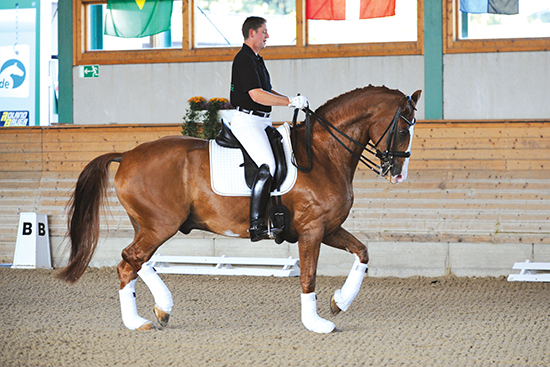
Demonstrating for Dr Plewa – Hans Bauer
And still the wonderful horses keep coming. Dietrich Plewa introduces Christoph Koschel riding the 11 year old Fantomas (Florestan / Pilot). According to Christoph: “I got him in March this year. When we got him he was trained to Prix St Georges, but I went straight to Grand Prix and this is his first Grand Prix season.”
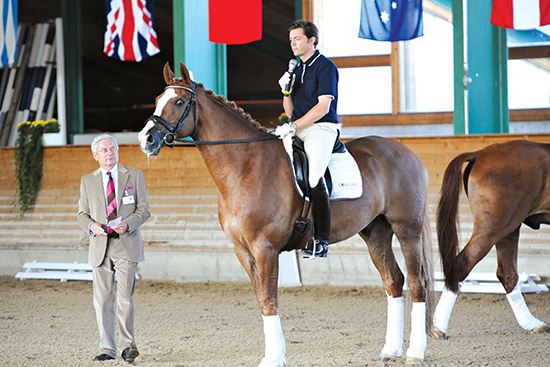
Dietrich Plewa and Christoph Koschel with 11 year old Fantomas
According to Dietrich: “We see we don’t need a double bridle to train this horse. Now Christoph is developing the collected canter we need for the half pass (we should note that the horses had all been warmed up outside before being brought into the arena) but there is no changing of rhythm and the horse keeps the impulsion. You see the horse is bent through its whole body with a good uphill tendency. In the changes of hand, we see a smooth contact all the time, and fluent flying changes. We see in the one times changes, an ambling canter as the horse moves to a two beat rhythm. You don’t often see flying changes so fluent, so straight. This horse very well fulfills the criteria of the Training Scale: rhythm, impulsion, straight, smooth contact – able to collect. That is what we want to see, changes that are fluent, straight and with expression – without being pushed by the rider. I’m sure he could ride this movement with one hand…”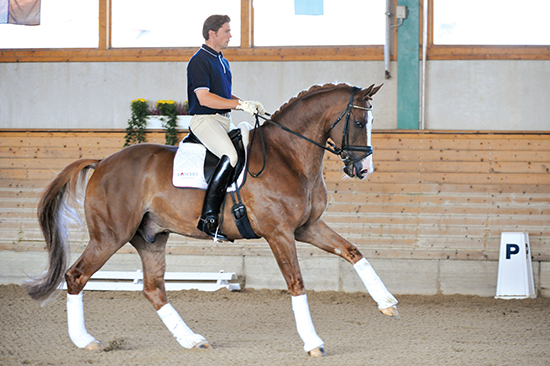 And of course, that is just what Christoph does!
And of course, that is just what Christoph does!
They were certainly beautiful changes, but Fantomas, had an even more astonishing walk…
Dietrich points out that “often in Grand Prix we see horses with a poor walk – but this horse often gets 9s and 10s for walk. Look you could easily give a 10 for this extended walk.” And guess what? The collected walk is just as clean and defined
Still the stars keep rolling into the arena. We have Germany’s assistant National Coach, Johnny Hilberath, working with the enormously talented Carola Copellmann on the ten year old Trakehner stallion, Insterburg. The pair starred a few years ago at the Bundeschampionate, but last year, started out in Grand Prix.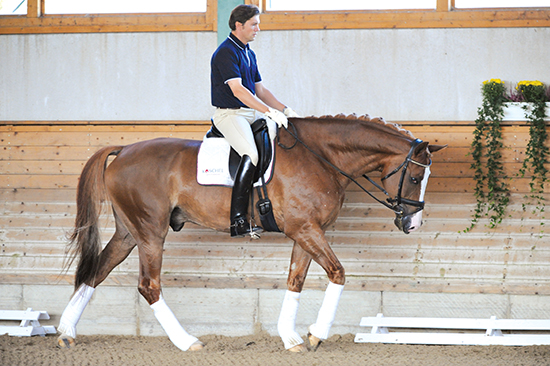
Jonny Hilberath is one of the German secret weapons as they prepare to take back the world dressage crown. A Grand Prix rider himself, Johnny is a real horseman, and seems to have the knack of getting the best out of the riders. He is enthusiastic about Carola and her horse:
“I like a lot the natural elasticity and cadence. This horse is well-connected in his body, he must be a pleasure to ride… and this is a very attractive combination, which helps. We see that the horse trots in the same rhythm sideways as he does forward, this is not the rider, this is the horse’s own self carriage.”

Carola Copellmann on Insterburg with Jonny Hilberath watching on
Like all the trainers we’ve seen at the Seminar, Jonny is quick to give the horse a breather. “They need breaks so the horse’s body and soul can refresh.
“This horse has a natural dynamic in canter with a very good forearm. This is the ideal canter not too big. Insterburg is so naturally collected, we always have to remember to open his frame.”
Carola is riding Insterburg in a series of short half pass diagonals. Even the coach is impressed: “I would be very happy if I could ride half passes like that in my own test…”
In thanking Carola for her display, Christoph remembers that the idea for this Seminar started three years ago, when we brought a group of Australians on our THM Sporthorse tour to Warendorf: “Thank you Carola, and the Australians, because three years ago, we had Carola and her horse, and we ran a little seminar for the Australians, and it worked so well, we thought, why is it just for Australians? And that is how we are all here now.”
Hubertus Schmidt – Piaffe and Passage
The last of our demonstrations is the Dutch stallion, Prego. The 12 year old chestnut has competed Grand Prix, and Hubertus – once he gets him warmed up and used to the arena – is going to talk about piaffe and passage, and demonstrate while he talks.
“I start teaching piaffe when the horse is six years old, because they need to be physically strong. At seven the horse is doing Prix St Georges, and at eight, Grand Prix – that means you have two years to prepare piaffe. First teach piaffe, then passage. First the horse has to be really sitting and taking the weight – it is easy with a talented horse to collect the trot and go to passage, but it is also easy to get the horse out behind.”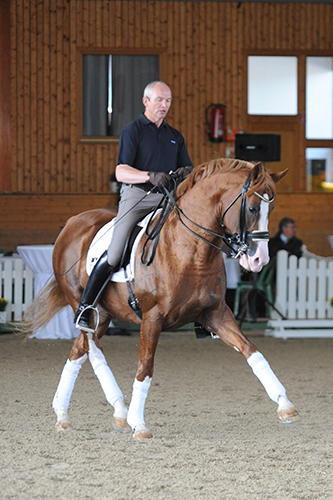
“We start with a swinging trot, collected and supple, moving through the whole body. For a good collected trot it is not just cadence – it is a good swinging. When I look at five year old horses, that’s what I ask – can I make the trot swing through the whole body.”
“In a balanced, collected trot, I ask for some half passes, this is the best way to be sure that the horse takes the outside rein, and is equally on both reins. 90% of uneven steps in piaffe come from the horse being too strong on one rein. For me, it is important that I can give the inside rein.”
“I start piaffe, mostly sitting on the horse although some I start in hand, always from collected walk and just playing, jogging in this walk. There are three really important things in piaffe. One is that the horse has to be always willing to go forward, the second is to play with how high, how low, the horse’s neck is. If you get them up, it is easier to start piaffe, but if you can get them lower, it is easier over their back. The other important thing is that the horse is sensitive to the legs and doesn’t need the whip.”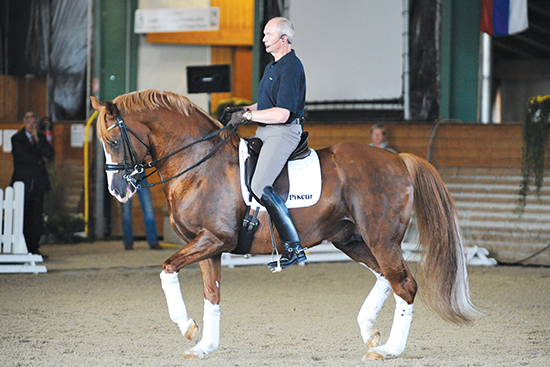
“In piaffe, always trot out so the horse keeps the forward. Be careful, sometimes they are uneven, shorter in one leg, and 90% of the time that is the result of not steady contact. So I do a turn in piaffe for two reasons, to the stiff side to loosen the inside rein, and also to get the horse to take weight on the inside leg. At home, I seldom do 15 piaffe steps on the spot, I do seven or eight, forward, a few more, forward.”
Time to move on to passage:
“It is easier from a swinging trot to get into passage. I’m happy with this passage, not everybody is Totilas! He is steady on both hands, regular behind – then always forward again. After we have done from trot to passage, the next step is from extended trot to passage. Especially for the young horses, I always like them going forward from the passage.”
“It is very important to prepare piaffe in the passage. Make the passage more active, then sit quiet for the transition. The rhythm is slower in passage, quicker in piaffe, you must give the horse time to change the rhythm – often riders push too fast in the transitions.”
Hubertus is demonstrating how he prepares the horse for the transition to passage / piaffe from walk riding through the short side: “I walk very quiet, it is good for the judges to see the relaxed walk, then I wake him up a little in the corner, so he is ready for the passage, then coming to the piaffe, a little tick, tick with the spur, sit quiet and come to piaffe…”
“This is the way we like to see it,” exclaims Christoph Hess – and so say all of us.
It has been a truly exceptional display. I cannot imagine anywhere else in the world that could produce a lineup of speakers, demonstrators, and most of all, horses, like the ones assembled for this first Bundeschampionate Seminar in Warendorf. Christoph Hess is already hard at work planning the next one for two years time – it should be sensational!
This article first appeared in the January 2010 issue of THM.


